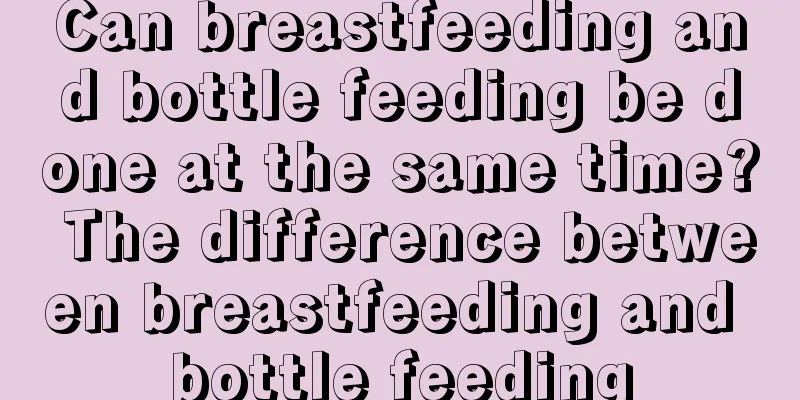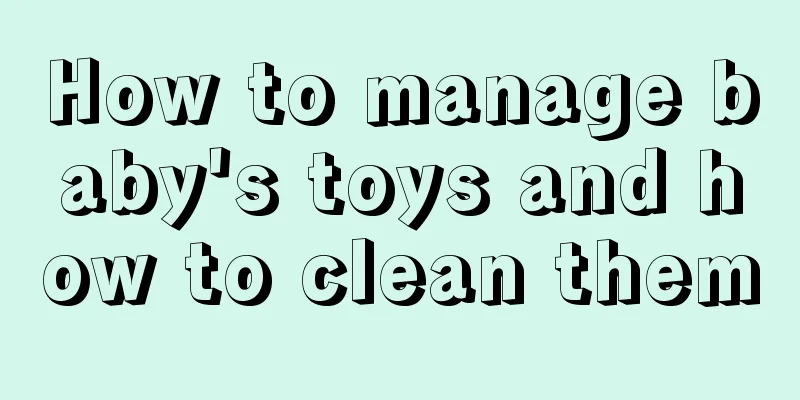Can breastfeeding and bottle feeding be done at the same time? The difference between breastfeeding and bottle feeding

|
Nowadays, few mothers feed their children with formula milk from birth. They all breastfeed. There are two ways to feed a child, breastfeeding and bottle feeding. What is the difference between the two? Can I breastfeed and bottle feed at the same time?Can. For mothers, it is possible to bottle-feed and breastfeed at the same time, especially for working mothers. Breastfeeding is now advocated, and some people let their babies suck directly after birth, while some people choose bottle-feeding for various reasons. In fact, these two methods are not contradictory, and there is no harm in doing them at the same time. In addition, there are some unexpected benefits, so don't worry. What are the benefits of breastfeeding and bottle feeding at the same time?1. Solve the problems of nipple pain and nipple inversion caused by mothers feeding, and reduce the baby's dependence on the mother's nipple. ① The problem of nipple cracking: Some mothers have incorrect feeding methods. When the baby drinks milk, he only holds the nipple but not the nipple and areola at the same time, which is not conducive to stimulating the production of milk. When the baby is hungry and cannot suck milk, he will increase the strength, and the skin of the chest is particularly delicate, which will cause cracking. If some mothers have serious nipple cracking, the editor recommends that mothers should not continue breastfeeding at this time. Mothers can squeeze breast milk into the bottle and feed with the bottle. Some mothers are worried that the baby will reject the bottle. Here, the editor recommends the natural original series of glass bottles from Avent to mothers. Avent's natural original glass bottles use glass as the main material, which is safe and secure; the unique petal-shaped nipple design is similar to the breast shape of breast milk, which is more acceptable to the baby. The nipple is soft and tough, similar to the touch of breast milk, and will not cause nipple confusion in the baby. When mothers' nipples are healed, they can breastfeed. ② Problems with inverted nipples Some mothers with inverted nipples find that their babies cannot suck on their nipples and cannot breastfeed when they are feeding their babies. Some mothers feel very frustrated. The editor recommends a method here. First of all, the editor wants to say that mothers should never give up breastfeeding. Mothers can use a breast pump to suck out the milk and then feed with a bottle. Here, the editor recommends Avent's unilateral electric breast pump. The petal-shaped design can fit the breast shape of breast milk well and stimulate the secretion of milk. It not only improves the efficiency of sucking milk, but also shortens the time of sucking milk. Mothers don't have to worry about back pain due to the need to lean forward for a long time when sucking milk. Avent's unilateral electric breast pump allows mothers to choose their own comfortable posture to suck milk. At the same time, mothers can use a nipple corrector to gently pull the nipple out and twist the nipple with their fingers; of course, mothers should also let the baby hold the nipple in their mouths and slowly suck the nipple out, alternate between breastfeeding and bottle feeding, so that the baby can always be breastfed. 2. Alternate breastfeeding and bottle feeding to reduce the burden on mothers. Some mothers return to work after maternity leave. In order to allow their babies to continue breastfeeding, they begin to consciously train their babies to drink milk from bottles early on. Before going to work, mothers can use a breast pump to suck out the milk. After going to work, relatives can feed the baby with a bottle. When it’s time to get off work, mothers can breastfeed. This method greatly reduces the burden on mothers and allows breastfeeding to continue. 3. Let the baby get used to bottle feeding and prepare for weaning in the future. Some mothers insist on breastfeeding, which will make the baby dependent on the nipple, which is not conducive to weaning in the future. Weaning is a gradual process. When feeding the baby, mothers can breastfeed and bottle feed at the same time to reduce the baby's dependence on the nipple, get used to bottle feeding, and prepare for weaning in the future. The difference between breastfeeding and bottle feeding1 Breastfeeding is less prone to bloating than bottle feeding. Babies are often prone to bloating when they are young, because they swallow a lot of air while feeding. Breastfeeding can effectively reduce the baby's bloating. This is because the nipple on the bottle and the mother's breast structure are essentially different. When using a bottle to feed the baby, it is very likely that the baby will swallow air, causing the baby to have bloating, hiccups, choking, spitting up milk and other adverse conditions. In addition, the nipples of some bottles are relatively hard, which may cause the baby to not eat well and affect the baby's physical development. Therefore, even if you want to feed the baby with a bottle, you must choose a suitable bottle for the baby to prevent the baby from swallowing air while feeding. 2 Breastfeeding is less likely to lead to overfeeding than bottle feeding. When feeding babies with bottles, they eat very quickly, and the same amount of milk is finished in a relatively short time, which makes it easy for the mouth to be hungry but the stomach to be not. In addition, when babies are just born, their stomachs are only the size of marbles, and they eat very little at each meal, so they need to be fed constantly. However, it is easy to feed too much breast milk if you squeeze breast milk into a bottle. Parents are always afraid that the baby will not eat enough, so they prepare more. When the baby is full, parents think it is a waste to have some left, so they will continue to let the baby finish it, which easily causes the baby to be full every time they feed. Therefore, parents should strictly follow the standards every time they prepare milk for their babies, and control the amount of milk according to the markings on the bottle. 3 Bottle-feeding breast milk can easily cause hygiene problems. Breast milk also has a shelf life. If the breast milk is squeezed out and left for a long time, it is very likely to deteriorate. If the baby drinks the spoiled milk, it will cause diarrhea and other symptoms. Therefore, parents must do a good job of storing the breast milk. After the breast milk is squeezed out, make a plan according to the baby's feeding time. Milk that is not used temporarily must be marked with the date in a milk storage bag and refrigerated in the refrigerator, and then taken out and heated when needed. 4 It is difficult to control the temperature of breast milk when feeding with a bottle. When breastfeeding, the temperature is body temperature, but it is different when using a bottle. The mother herself is a natural insulator. The milk sucked from the breast is at a temperature suitable for the baby to eat, and the milk squeezed out needs to be artificially kept warm. If it is cold, it needs to be heated. If it is too soft, it will cause diarrhea in the baby. If it is too hot, it needs to be cooled down, otherwise it will cause burns in the baby's mouth. Therefore, it is recommended that parents who often feed their babies with a bottle prepare a milk warmer so that the child can drink milk at a suitable temperature. When can I bottle feed my breast milk?Generally, you can persist until the milk naturally stops flowing. Many new mothers cannot grasp the time of bottle feeding, and always think that they should stop bottle feeding after a certain period of time. In fact, this idea is incorrect. For breastfeeding women, if they need bottle feeding due to fetal sucking, they can generally persist until the milk stops flowing naturally. This is because as long as breast milk is secreted, you can use a breast pump to regularly suck out the breast milk, and then put it into the bottle for feeding. After the baby is used to drinking milk from the bottle, he can continue to feed with the bottle, so as long as the woman has not stopped drinking milk, she can continue to bottle feed. |
Recommend
Is it better to have fluoride or non-fluoride toothpaste? How to choose the best toothpaste?
Toothpaste is a common item in our daily life. We...
Can pregnant women eat chives? Don't eat too much
Pregnant women can eat chive flowers, and eating ...
Why do children not eat? Tips to stimulate children's appetite
It is normal for children to be naughty and hyper...
What are the common causes of blindness in children and how to treat them
Parents all hope that their babies will grow up h...
Is it really necessary to do passive exercises for babies? Are passive exercises really beneficial?
On Weibo, there are sometimes some videos of pass...
Why are women most attractive during ovulation?
According to a US study, women are most attractiv...
What is the main force of labor? How to push during labor?
Many pregnant women don’t know how to exert force...
How is the quality of Supor thermos cup? What is the material of Supor thermos cup?
Now that the weather is getting colder, I need to...
How to cultivate your baby's interest in English from an early age
Nowadays, social competition is becoming more and...
How old can a baby's nails be cut? The correct way to cut a baby's nails
Cutting a baby's nails is a big project. When...
What causes pharyngitis in children? Can pharyngitis in children heal itself?
Inflammation of the throat is a disease caused by...
The harm of children's snoring Is children's snoring caused by rhinitis
Snoring in children is a common symptom in daily ...
Can the husband accompany the birth? Is it okay for the husband to accompany the birth?
In foreign countries, it is very popular for pare...
What is Mermaid Syndrome and How to Prevent the Birth of a Mermaid Fetus
I believe everyone knows the love story of mermai...
What kind of shoes should I wear during confinement in winter? What kind of shoes should I wear during confinement in winter?
Mothers who are in confinement in winter must pay...









